“the quiet enjoyment of one’s property”
by Brian Wright
private nuisance:
 n. the interference with an individual’s peaceful enjoyment of one’s property, which can be the basis for a lawsuit both for damages caused by the nuisance and an order (injunction) against continuing the noxious (offensive) activity or condition. Examples: fumes from a factory above the legal limit, loud noises well above the norm, directing rain water onto another person’s property, operating an auto repair business in a neighborhood zoned residential, or numerous barking dogs… [and government-highway noise?]
n. the interference with an individual’s peaceful enjoyment of one’s property, which can be the basis for a lawsuit both for damages caused by the nuisance and an order (injunction) against continuing the noxious (offensive) activity or condition. Examples: fumes from a factory above the legal limit, loud noises well above the norm, directing rain water onto another person’s property, operating an auto repair business in a neighborhood zoned residential, or numerous barking dogs… [and government-highway noise?]
—courtesy law.com
Farmington Hills, Michigan, January 2010
Joan Barber has been living on the edge for 30 years—the edge of a good share of the issues of suburban sprawl (or should we call it suburban maul?): eminent domain, transportation autocracies, congestion, and noise. Especially, noise!! (70-75 decibels continuous depending on the time of day.)
In 1959 she and her husband, Bob, moved into the historic farm property passed down to him from his mother, descended from one of the region’s founding families. The area—on the far northwest boundary of Detroit—was all farmland then. But progress was on the march: the Eisenhower-era Interstate-Highway Juggernaut, (certainly one of the largest corporate-welfare projects in history) had come to Michigan: the state that made the automobile mandatory.
As a Baby Boomer who was 10 years old in 1959, I can only imagine the technocratic mass hysteria afflicting my parents’ generation, when New York City’s megalomaniac city planner Robert Moses walked among us preaching the Gospel of Heavenly Alloverya Concrete. Legions of Moses’ clones spread into the Hinterland. Armed with home mortgage subsidies and the right of public ‘taking,’ they enthusiastically led an American exodus of Biblical proportions into the pastoral countryside.
But I don’t have to imagine the car hysteria of the time. As teenagers, my brother and I added to the already enormous materialistic pressures on our 30-something parents to keep up with the Joneses: “Geez, Pop, all my friends have cars. Lloyd has a brand new GTO; his dad is, like, a shoe salesman! How can I become an adult if I don’t have the tools society demands of me?”
Anyway, whatever Madison Avenue-induced cravings the debt-fueled post-WW2 culture rained down on the ‘Greatest Generation,’ the whole of America was feverishly expanding. And, by golly, no one—no clodhopper property owner; no pot-smoking, Thoreau-spouting beatnik; no somber, gray-haired preservationist —was going to stand in the way.
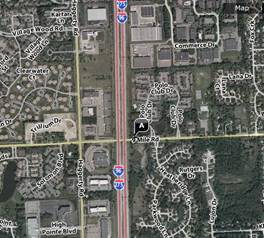 Certainly Bob and Joan Barber and their four children in “We Don’t Care Where You Live,” Michigan, were not going to hold up the construction of I-275 in the late 1960s. Though I’ve never known anyone who worked for the highway department, I can readily imagine the power-high of some Walter Mitty of the MDOT as he rolls out his official surveyor maps and plays God with a red pencil. “Hmmm, let’s see what we have here. I don’t think these people will put up much of a fuss. But, then, hey, who cares? I’m God.” Actually, God would probably give a fair market price.
Certainly Bob and Joan Barber and their four children in “We Don’t Care Where You Live,” Michigan, were not going to hold up the construction of I-275 in the late 1960s. Though I’ve never known anyone who worked for the highway department, I can readily imagine the power-high of some Walter Mitty of the MDOT as he rolls out his official surveyor maps and plays God with a red pencil. “Hmmm, let’s see what we have here. I don’t think these people will put up much of a fuss. But, then, hey, who cares? I’m God.” Actually, God would probably give a fair market price.
And so it would go. The thoroughfare was platted within a large stone’s-throw of the Barber domicile. In 1967 the Barbers were informed of the Mitty-Group decision and in 1968 they were obliged to go to Lansing (Michigan’s capital) to pick up a check for $10,000… for which they received no document describing the ‘agreement’ or terms of the government’s taking. Then, as you can see from the insert, the Caterpillar brigades ravaged the land without so much as a ‘thank you, ma’am.’
Keep in mind, that in 1976, when the road went thru, virtually every building you see except ‘A’ (the Barber residence) in the hybrid-satellite map above was not there. None of the subdivision roads, none of the subdivisions, none of the industrial parks. Northwest of the intersection of Haggerty and Nine Mile Road was open land—full of creeks, ponds, muskrats, and wild turkeys.
So how much trouble, back then, for the state to put up a decent sound wall?
Farmington Hills, July 2009
This particular story of Joan Barber and the noise abatement wall (NAW) begins on a pleasant summer’s day, as I’m coming back from a round of golf at Whispering Willows GC in Livonia. The stretch of Nine Mile Road where the Barber Farm is located is only half a mile from where I live on the other side of Interstate-275. I had never paid much attention to the surroundings near the 9-Mile underpass but today something catches my eye…

What’s with the banners?
Just like the picture at the beginning of the article without the snow cover. As an underemployed freelance writer and a naturally sympathetic advocate of poor saps who get run over willy nilly by the Leviathan (Corporate-State), I find my curiosity piqued. I come back the next day to leave a note, then notice another sign, of cast iron, marking the old home as a Michigan historical site.
Stephen Yerkes Rodgers House
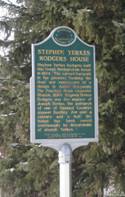 [Sign says:] Stephen Yerkes Rodgers built this Greek Revival-style house in 1834. The carved fretwork in the pilasters flanking the door are reminiscent of a design in Asher Benjamin’s The Practical House Carpenter (Boston, 1830). Stephen Yerkes Rodgers was the nephew of Joseph Yerkes, the patriarch of one of Oakland County’s pioneer families. For over a century and a half, the house has been owned continuously by descendants of Joseph Yerkes.
[Sign says:] Stephen Yerkes Rodgers built this Greek Revival-style house in 1834. The carved fretwork in the pilasters flanking the door are reminiscent of a design in Asher Benjamin’s The Practical House Carpenter (Boston, 1830). Stephen Yerkes Rodgers was the nephew of Joseph Yerkes, the patriarch of one of Oakland County’s pioneer families. For over a century and a half, the house has been owned continuously by descendants of Joseph Yerkes.
Whoa, not only is the victim of Leviathan a poor soul, he or she is a poor soul with a really spiffy official plaque in his/her front yard that the Leviathan is treating with absolutely zero respect. One would think if anyone with a beef has a chance of justice, then it would be someone that Leviathan itself has designated as living on special property.
It wasn’t obvious that the house was still occupied. But if anyone was still living there, he or she would see my note when they opened the gate. This was last summer and I wrote a task to myself to check out the Stephen Yerkes Rodgers House for any signs on the Web of someone manifesting a “last great act of defiance” in the newspapers or some other media besides yard banners.
 [Here I can’t resist inserting the image, which I presume is public domain after all these years, of a little defenseless mouse standing up to this ferocious eagle about to swoop down upon him. There’s something about the hopelessness of the picture that nonetheless instills hope in me: like Bernard von Nothaus (creator of the Liberty Dollar) being set upon by the Treasury Department or Pete Hendrickson (author of Cracking the Code, story of the misapplied federal “income” tax) being silenced by the IRS.]
[Here I can’t resist inserting the image, which I presume is public domain after all these years, of a little defenseless mouse standing up to this ferocious eagle about to swoop down upon him. There’s something about the hopelessness of the picture that nonetheless instills hope in me: like Bernard von Nothaus (creator of the Liberty Dollar) being set upon by the Treasury Department or Pete Hendrickson (author of Cracking the Code, story of the misapplied federal “income” tax) being silenced by the IRS.]
Little do I realize that with respect to the sound wall campaign the seeming mouse in the image is a diminutive widow of a member of the Yerkes Rodgers clan. This is her story, really, sadly, as it would turn out, almost wholly her own.
Life on the Old Homestead
Sure enough, a week or two ago I receive a call from a woman identifying herself as the banner lady. It’s been six months, I figured that kettle was going to stay on the back burner forever. So I’m really excited to hear from her, if only for the curiosity angle: this has to be a really good human story. How had the system wronged her, and what could be done about it? She agrees to an interview the next day.
 It’s been a mild winter so far, but three inches of snow cover the ground. The entrance to her home is up a long driveway that hasn’t been shoveled; I asked her yesterday if I had to worry about any ferocious watchdogs and she laughed, “Only a 16-year-old yard mutt who can hardly walk or see, and another one I keep inside.” You can see Joan restraining her—actually, I think the dog is laying down wanting to play—in the photograph on the left as I drive in the gate, probably soothing her: “Easy, Maggie. Easy, girl, this man is not the head of the department of transportation… or any of those political ones we trained for.”
It’s been a mild winter so far, but three inches of snow cover the ground. The entrance to her home is up a long driveway that hasn’t been shoveled; I asked her yesterday if I had to worry about any ferocious watchdogs and she laughed, “Only a 16-year-old yard mutt who can hardly walk or see, and another one I keep inside.” You can see Joan restraining her—actually, I think the dog is laying down wanting to play—in the photograph on the left as I drive in the gate, probably soothing her: “Easy, Maggie. Easy, girl, this man is not the head of the department of transportation… or any of those political ones we trained for.”
Also from the photo witness that the Barber (Yerkes-Rodgers) estate is a classic old farm property with several out-buildings, a variety of trees, and a unique personality developed over many generations. Before entering the house, I walk around and snap a few more shots.
As you view the collage below keep in mind that to your west approximately 100 feet lies the centerline of a maelstrom of honking/weaving Peterbilts, school buses, soccer-mom vans, and mastodon condomobiles in a hurry to get south… or north to spread in all directions. Believe me, it’s a fair rush of sound, even with the deadening effects of the snow and the branches of a handful of evergreens.
[Nine-Mile and I-275 is a half mile south of the end of the freeway, which becomes a Grand Diaspora of interchanges: to I-696 E, to I-96 W, to M-5 N, to M-5. The four northbound lanes of 275 feed a grand total of 15 lanes every which way but loose. Perhaps you’ve noticed in your own expressway driving that when people exit one highway, at high speeds along wide sloping curves, onto another with equal or more lanes, they tend to drive like mad fools. Pedal to the metal, cellphone crammed to the head, not looking around or backward.]
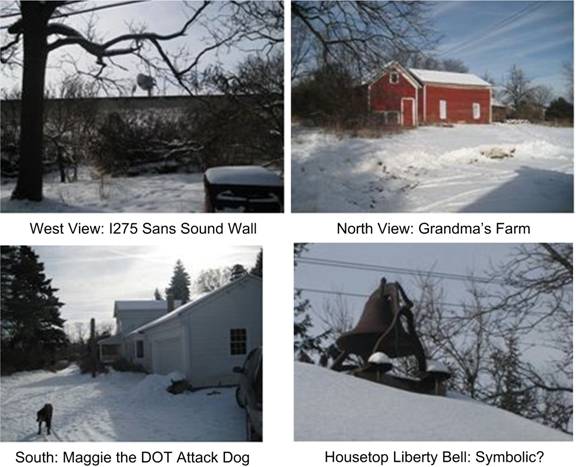
The collage provides a good feel for the lay of the land, how Joan and her lovable creatures are situated next to the roaring traffic. Maybe this is a good time to emphasize that The Yerkes-Rodgers/Barbers were here first. This isn’t a situation where a subdivision rams its little boxes into the end of the runway at Detroit Metro then the people moving into the boxes sue because all of a sudden the noise level ruins their sleep. Plus, when the Barbers handed over their deed, they were told six lanes only: the photo below shows the throbbing eight-lane artery from the west side of the superslab.
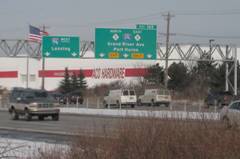 So we enter the old home and I take off my shoes and look around. Shake hands, say hi. She makes some tea. It’s a charming interior, full of Joan’s own family memories, not to mention the artifacts, images, and possibly spirits of 175 Christmases past. Wow, it hits me then, even in the midst of the normal get-acquainted nerves: This building is a living connection, not only to Ms. Barber’s ancestors, but to my ancestors, to our ancestors… breathing, struggling, marrying, birthing, laughing, crying people who carried on right here in their own hallowed spot of the universe.
So we enter the old home and I take off my shoes and look around. Shake hands, say hi. She makes some tea. It’s a charming interior, full of Joan’s own family memories, not to mention the artifacts, images, and possibly spirits of 175 Christmases past. Wow, it hits me then, even in the midst of the normal get-acquainted nerves: This building is a living connection, not only to Ms. Barber’s ancestors, but to my ancestors, to our ancestors… breathing, struggling, marrying, birthing, laughing, crying people who carried on right here in their own hallowed spot of the universe.
The personal realization bowls me over for a moment… and lends a newfound affection in my heart for all the good souls walking to the beat of the different drummer of historical preservation. As I turn on the tape recorder and pull out my notepad, I ask Joan how she is related to the founders and builders of this unique property. She informs me that her husband, Bob, is the link to the past. Through his mother to the Yerkes family. But I quickly lose track of the begats and begottens.
Bob and Joan had four children, a boy and three girls, all grown now, with families of their own. The son is often overseas with the Presbyterian Church—but he’s back in SE Michigan, Brighton area, for a while—and the daughters… one in Dexter, one in Royal Oak, one [?], I get the impression she doesn’t see her offspring that often, or vice versa. It also occurs to me—and is confirmed by Joan’s admission that Bob became increasingly disenchanted with her quixotic tilting at sound walls—that the family would rather Joan drop this holy cause that shows every indication to them of having a vanishingly small chance of success.
Farmington Hills, Spring 2012
Well, hope springs eternal. At least for some homesteaders… and some writers. My own motivation, in 2010, was twofold: a) seeing if by publicizing this plight of a private-citizen David I might generate enough grassroots energy to at least move the uncaring government Goliath(s) and b) to develop my freelance writing career. But for one reason or another, after generating what appears above, some other project acquired more priority and I forgot about good ol’ Joan of ‘Hark’ and her holy mission.
Now two and a half years later, on Mondays, Wednesdays, and Fridays, as I’m shuttling my mom back from dialysis at St. Mary Mercy I notice that Joan’s bright bold signs have disappeared. Did she give up? Expire? MDOT vandals? So I call the number I have for Joan and ask her what gives? In a clear, confident voice she assures me the signs are only down for cleaning, and yes she’s still pursuing all available avenues for getting her sound wall built. Her approach now is to get someone at Farmington Hills city hall to take an interest. As yet, no luck.
 Joan’s cause has quite a history in local journalism. Here on the left you see her in 2010 standing in her kitchen where she has innumerable notes, stories, and columns posted from the beginning. Below right is one of the earlier stories, approximately 25-30 years ago. While I interviewed Joan in 2010, I had the chance to read several of the news stories and commentaries from most of the dailies in SE Michigan—including the Detroit News, the Detroit Free Press, and the Oakland Press. Some of these pieces were positively inspiring: This Detroit News editorial on a related eminent domain case, Restoring Property Rights, wrote:
Joan’s cause has quite a history in local journalism. Here on the left you see her in 2010 standing in her kitchen where she has innumerable notes, stories, and columns posted from the beginning. Below right is one of the earlier stories, approximately 25-30 years ago. While I interviewed Joan in 2010, I had the chance to read several of the news stories and commentaries from most of the dailies in SE Michigan—including the Detroit News, the Detroit Free Press, and the Oakland Press. Some of these pieces were positively inspiring: This Detroit News editorial on a related eminent domain case, Restoring Property Rights, wrote:
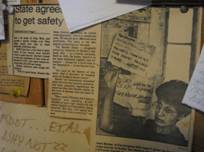
So I’ve decided to catch up and write a Part 2 of the Joan of Hark saga, get into the actual mechanics of what she is doing and what sensibly can be done. Also weigh in a little further on the broader issues of eminent domain, suburban development run amok, and the autocratic automotive transportation bureaucracy. In these days of massive federal encroachment on top of the ongoing day-to-day state abridgment of our rights, any decent journalist has to pick up the batons of hope and opportunity where they lie. Then to move along with them as best he or she can, to keep humanity in its race to one day break, forever, the shackles of the corporate state. I’m not sure Ms. Barber’s race can be won, but her cause is eminently reasonable, if not vibrantly just.
To be continued
This post has been read 3821 times!


Thanks, Randy. I’ve sent you a password to configure you as a user, so you should be able to reply on other posts without being moderated. Let me ask you–this new WordPress implementation I’m just learning as I go–were you prompted as to whether or not you wanted to become a user/subscriber when you replied to this post? bw
Well done and well written. I look forward to hearing more about this.